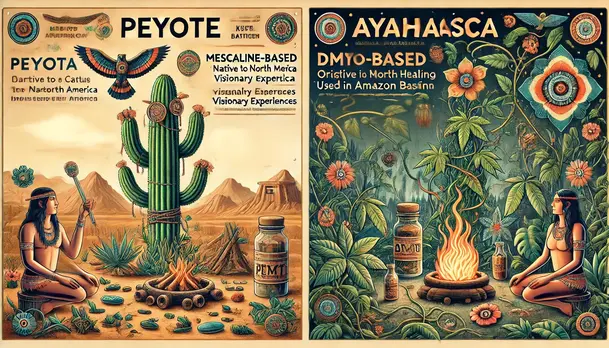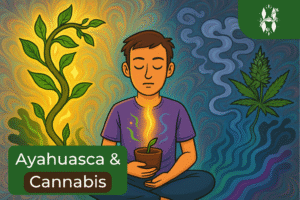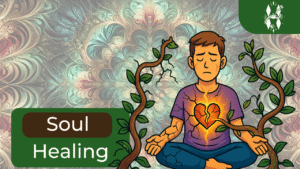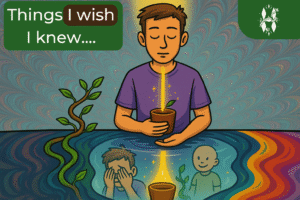We look at the differences and similarities between Peyote and Ayahuasca. Whether you’re looking to understand these two medicines or trying to determine which one might be the right fit for you, this blog will offer valuable insights to guide you.
Key takeaways
- Ayahuasca originates from the Amazon and is a brew made up of two plants from the jungle, while Peyote, from Mexico and the southern US, is a single cactus plant.
- Both plants plants are seen as wise elders, having existed long before us, carrying many teachings. Ayahuasca is generally thought of as the Grandmother spirit, and Peyote as Grandfather.
- Peyote’s slow growth and scarcity make it a precious resource, requiring a genuine calling for use. Ayahuasca is more abundant but also needs to be harvested sustainably.
Table of Contents
“This upright posture is said to be symbolic, likened to galloping on horseback across the landscapes of Mexico”
Disclaimer
It’s important to recognize that different traditions have their own unique ways of conducting Ayahuasca and Peyote ceremonies. This blog is a general overview, but your experience can vary a lot depending on who is facilitating the ceremony. To add, these are general guidelines and frameworks for how Ayahuasca and Peyote ceremonies are typically conducted. Your own personal, subjective experience may be distinctly different.
The truth is that nothing can fully prepare you for your own Ayahuasca or Peyote ceremony. It’s essential to have open conversations with the facilitators of the ceremony, ask any questions you might have, and ultimately make your own decision about which plant medicine is right for you.
Ayahuasca vs Peyote: Origins
Ayahuasca has its roots deep in the Amazon rainforest, where it has been used for centuries by indigenous tribes for spiritual and healing purposes. The medicine is a combination of two different plants: the Banisteriopsis caapi vine and the leaves of the Psychotria viridis shrub.
Peyote is a small, spineless cactus native to the deserts of Mexico and the southern parts of the United States. This cactus has been used for thousands of years by Native American tribes. Unlike Ayahuasca, which is a combination of two plants, Peyote is a single plant that contains the psychoactive compound mescaline.

Ayahuasca vs Peyote: Main Ingredients
DMT vs. Mescaline
The primary ingredient responsible for the psychedelic effects in Peyote is Mescaline, while in Ayahuasca, it is DMT (Dimethyltryptamine). Beyond these main compounds, Peyote contains over 60 different alkaloids, and Ayahuasca has more than 10, contributing to their complex effects on consciousness.
However, for indigenous cultures, the focus is less on these specific psychedelic molecules. They believe that these plants embody a spirit – a plant teacher that connects with you on a deeper level. When you consume these plant medicines, the spirit of the plant enters your consciousness and begins to work within you, guiding your healing and personal growth. The experience is seen as a spiritual journey facilitated by the plant’s spirit, rather than just a chemical reaction.
Ayahuasca vs Peyote: Similarities
Both Peyote and Ayahuasca are powerful plant medicines that allow you to delve deep into your subconscious. They help you gain a clearer understanding of what is happening in your life – what you’re doing well, what you might be doing wrong, and areas that need correction.
These medicines can bring suppressed emotions to the surface, providing a reality check on your life and enabling you to process past emotional impacts that still affect you today.
They can offer a vision for how you want to live your life moving forward. Both Ayahuasca and Peyote are incredibly powerful tools found in nature for self-discovery, healing, and personal transformation.
Master Teachers: The Grandfather and Grandmother Spirits
Both Peyote and Ayahuasca are considered sacred medicines by the indigenous tribes that share them. It’s crucial to approach these plant teachers with deep respect, humility, and intention for healing and growth. These medicines are not just substances to “try” for the sake of seeing colors or having an experience; they are powerful spiritual guides that require a serious and respectful approach.
Among many traditions, Peyote is often referred to as the “Grandfather” spirit, while Ayahuasca is known as the “Grandmother” spirit. These plants are seen as wise elders, having existed long before us, and carrying profound teachings. Engaging with them in a ceremonial context is essential to truly connect with their wisdom and guidance. In the traditions of Colombia, Ayahuasca is also known as Yagé and is revered similarly, embodying both the Grandfather and Grandmother spirits.
The importance of connecting with these plants in a ceremonial setting can’t be overstated. They offer much more than just a psychedelic experience – they are here to teach us, to help us heal, and to guide us on our spiritual journeys.
Must read blog: What is Yagé?
Peyote Ceremony: What to Expect
One of the big differences between Peyote and Ayahuasca ceremonies is the level of structure and discipline often found in Peyote ceremonies. From the way I know Peyote ceremonies to be, they tend to be quite strict.
Participants are typically required to sit upright for the entire ceremony, which can last up to 12 hours, often without the support of a backrest. This upright posture is said to be symbolic, likened to galloping on horseback across the landscapes of Mexico, embodying a strong and resolute stance. Maintaining this posture for an extended period can be tough physically.
Also, there are specific protocols for entering or leaving the circle during the ceremony, such as when one needs to go to the bathroom.
While many people describe Peyote as not being as intense as Ayahuasca, this largely depends on the dosage of Peyote consumed. The effects can vary significantly based on how much Peyote is taken, and in some cases, the experience can be just as profound and transformative as Ayahuasca.
Prayer in the Peyote Ceremony
Much like in San Pedro ceremonies, Peyote ceremonies are often guided by prayers and teachings shared by the medicine giver. These prayers and discussions are central to the ceremony, helping to set the tone and guide the participants through their spiritual journey.
A friend of mine once shared an experience from a Peyote ceremony where the leader of the tribe spoke at length about the importance of water. The leader described water as an advanced technology, essential not only for our bodies but also for the natural world around us. Such teachings serve as powerful reminders of the interconnectedness of life and the value of the natural elements we often take for granted.
There’s a saying that the medicine giver in Peyote ceremonies needs to be “good with his words.” This reflects the importance of communication in these ceremonies, where the words spoken by the leader carry significant weight. The ceremony is often a communal experience, where participants share their prayers, intentions, and songs, creating a collective atmosphere of healing and connection.
Must read blog: Ayahuasca vs San Pedro
“This upright posture is said to be symbolic, likened to galloping on horseback across the landscapes of Mexico”
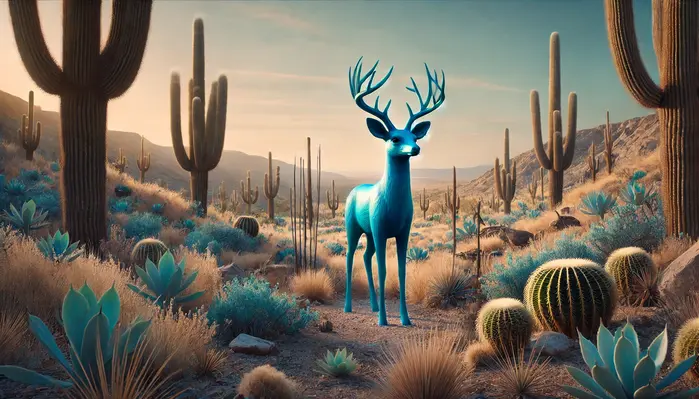
The Temazcal: The Womb of Mother Earth
After Peyote ceremonies, it is common to participate in a Temazcal, or sweat lodge, to close out the ceremony. The Temazcal represents the womb of Mother Earth, offering participants a space to be reborn and cleansed after their spiritual journey with Peyote.
Once inside the sweat lodge, participants are encouraged to remain until the ceremony is complete. The ritual typically involves four “doors,” or rounds, during which the lodge is briefly opened to bring in fresh air and new volcanic stones, which are then heated. Once the doors are closed again, water is poured over the stones to create steam, intensifying the heat inside the lodge.
Throughout the Temazcal, participants share songs and prayers, creating a communal and spiritual atmosphere. The experience can be especially transformational when combined with the aftereffects of Peyote.
In Contrast to Ayahuasca
In the Ayahuasca ceremonies that we conduct, the focus is on helping participants connect deeply with the plant and allowing the plant to teach them. While some may discover the importance of water, others might not; the journey with Ayahuasca is highly individual. Each participant is encouraged to form their own connection with the plant, allowing Ayahuasca to develop in them according to their personal intention or what the plant itself wants to reveal.
Ayahuasca ceremonies are communal in nature, but the experiences are often very personal. What comes up during the ceremony is unique to each individual, guided by the spirit of Ayahuasca in response to their personal needs and intentions.
Physically, Ayahuasca has its own demands on the body, such as nausea and vomiting. Entering a ceremony requires a warrior spirit to face these challenges. While it’s recommended to sit, especially before vomiting to aid digestion, this rule is not as strict as the posture requirements in a Peyote ceremony. The focus in Ayahuasca ceremonies is more on the inner journey and what the plant reveals rather than maintaining a specific physical posture.
Must read blog: Why you vomit on Ayahuasca
The Totems of Ayahuasca vs. Peyote
Peyote: The Blue Deer
In the Peyote tradition, the Blue Deer holds significant spiritual importance. There is a story that during a time of great drought and food scarcity, four young men were sent out to hunt. Eventually, a Blue Deer appeared, leading them on a journey.
They followed the deer and, when they finally shot an arrow at it, discovered that it had transformed into a cactus shaped like a deer. This cactus was Peyote, and they brought it back to their people, marking the discovery of this sacred plant.
The Blue Deer is not only a symbol of Peyote but also a spiritual guide in ceremonies. Those who take Peyote often report seeing blue lightning and encountering the Blue Deer in their visions.
Ayahuasca: Jaguar, Anaconda, Guacamayo
In Ayahuasca ceremonies, many people report visions of powerful jungle animals such as Jaguars, Anacondas, and Guacamayos (macaws). These animals are considered protectors of the jungle and carry deep symbolic meanings within the Ayahuasca tradition.
The Jaguar represents strength and a deep connection with one’s instincts. It is often seen as a guardian and a symbol of courage and power.
The Anaconda or snakes in general symbolizes transformation and transmutation, embodying the themes of death and rebirth. It is associated with the cosmic serpent, a powerful figure in many indigenous mythologies.
The Guacamayo (macaw) is a representation of love and joy, bringing color and vitality to the visions of those who encounter it.
Must read blog: Ayahuasca Animals
“due to the slower growth and limited availability of Peyote, there is a strong belief that one should feel a deep calling before engaging with Peyote”
The Shortage of Peyote
Harvest and Sustainability of Peyote
Peyote is a slow-growing cactus, and in its natural desert conditions, it can take around 10 to 15 years to reach maturity. Even under more controlled circumstances with optimal light and care, it can still take about 5 years for Peyote to be ready for use. This slow growth makes it a more scarce resource.
In contrast, San Pedro, another cactus containing the psychoactive compound mescaline, grows much more quickly and is widely available. San Pedro and Peyote share many similarities, not only in their active ingredient but also in the way their ceremonies are conducted. However, due to the slower growth and limited availability of Peyote, there is a strong belief that one should feel a deep calling before engaging with Peyote, rather than simply trying it out of curiosity.
Harvest and Sustainability of Ayahuasca
This sense of calling can also apply to Ayahuasca, as it takes about 7 years for the Ayahuasca vine to mature. However, the Amazon rainforest, where Ayahuasca is primarily harvested, is much larger and more abundant. Despite this, it’s crucial to consider the sustainable use of both Peyote and Ayahuasca.
Supporting medicine givers and retreat centers that make efforts to cultivate these plants, rather than solely harvesting them, is important for the preservation of these sacred medicines.
For more information on the protection and sustainability of Peyote, you can refer to this article from The Guardian.
Conclusion
Both Peyote and Ayahuasca are sacred plant medicines revered for their profound ability to guide and heal individuals on a deep, spiritual level. While they originate from different regions—Peyote from the deserts of Mexico and the southern United States, and Ayahuasca from the Amazon rainforest—they share a common purpose: helping people connect with their subconscious, heal emotional wounds, and gain clarity on their life’s journey.
Peyote, with its structured and communal ceremonies, offers a unique experience that emphasizes discipline and connection through prayer and ritual. Its slow growth and limited availability make it a rare and precious resource, best approached with a genuine calling and deep respect.
Ayahuasca, on the other hand, provides a more individualistic and introspective journey, rooted in the rich traditions of the Amazon. Despite its wider availability, Ayahuasca demands a respectful approach, considering its significant physical and spiritual challenges.
Both of these plant spirits require a commitment to sustainability and respect for the cultures that have preserved their use for centuries. Whether you are drawn to Peyote or Ayahuasca, approaching them with intention, humility, and ethical consideration will ensure that their healing wisdom continues to benefit humanity for generations to come.
FAQs
What are the main differences between Ayahuasca vs Peyote?
Ayahuasca and Peyote differ in their active ingredients, origins, and effects. Ayahuasca primarily contains DMT and is associated with experiences that can be intense and emotionally profound. Peyote, on the other hand, contains mescaline, which tends to produce a more subtle and gentle experience. Ayahuasca is native to the Amazon, while Peyote is indigenous to northern Mexico and the southwestern United States.
How do Ayahuasca and Peyote affect the brain and body?
Both Ayahuasca and Peyote can induce powerful psychoactive experiences, but their effects on the brain and body differ. Ayahuasca’s DMT component leads to altered states of consciousness, sometimes visions, and intense emotional processing. Peyote’s mescaline causes visual and auditory distortions and can lead to spiritual insights or feelings of ego dissolution.
Is there a shortage of Peyote, and what are the sustainability concerns?
Yes, Peyote is a slow-growing cactus that can take up to 15 years to mature in the wild, leading to concerns about overharvesting and potential extinction.
Read more of our blogs here
